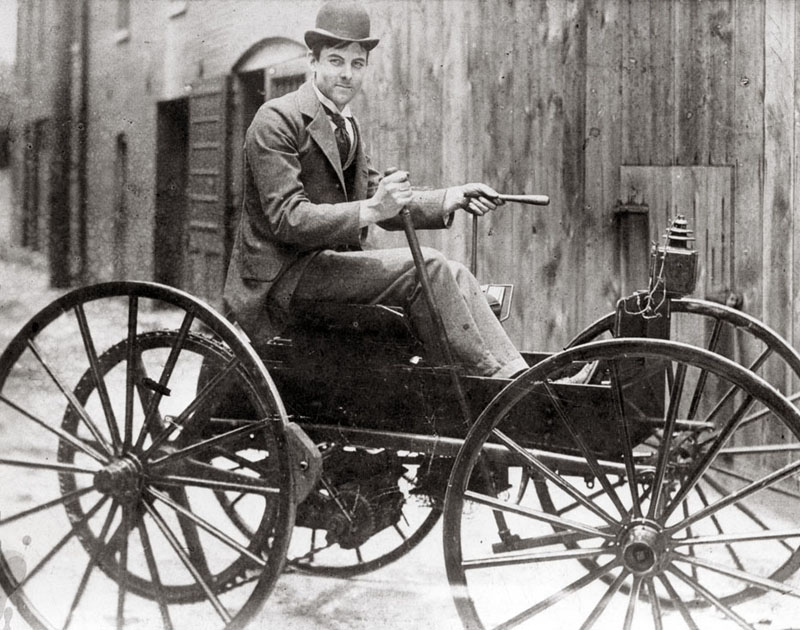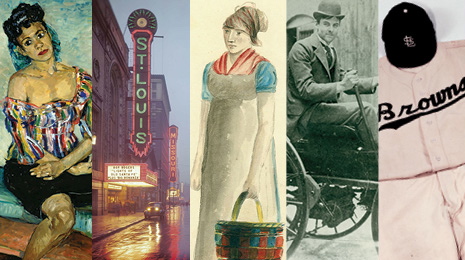November 7, (Friday), 2014 2:00 pm
SCHS Fall Daytime Presentation at Tesson Ferry Library
“St. Louis Moment by Moment” – Katie Moon, Exhibition and Research Assistant from the Missouri History Museum, will talk about moments in St. Louis history. In this year of the 250th anniversary of the founding of St Louis, the Missouri History Museum has its “250 in 250″ exhibit which features 50 moments. Discover some of the other moments in St. Louis’ history from the people who experienced it firsthand. Letters, diaries, oral recordings, and more provide revealing details from the past. Find out what it felt like to cross the Mississippi River in 1818, or be a part of the Great St. Louis Bank Robbery in 1953.
See directions to Tesson Ferry library.
Katie Moon’s blog post describing the 50 Moments portion of the 250 in 250 exhibit: “Exhibit Features 50 Eyewitness Accounts of Life in St. Louis.”
Exhibit Features 50 Eyewitness Accounts of Life in St. Louis
St. Louis turns 250 years old in 2014, and the Missouri History Museum will commemorate the anniversary with an exhibit that tells the history of the city through 50 people, 50 places, 50 moments, 50 images, and 50 objects. History Happens Here is taking its readers behind the scenes of the making of the 250 in 250 exhibit, which will open in February 2014.
We’ve all been there. You sit down with your family, or a group of old friends, and suddenly everyone is telling stories: “I remember when your Uncle Bob and I…” Or your grandmother starts talking about what life was like during the Great Depression, and it’s just riveting. You can tell by the look in her eyes and the expression on her face that as she’s speaking, she’s reliving that time of her life.
Our goal with the Moments section of the 250 in 250 exhibit is to share 50 of these types of stories—providing a glimpse of “real-life” history—described by the people who actually lived it. It’s sort of like a family reunion that includes about 10 generations of St. Louisans.

J.D. Perry Lewis built this battery-powered horseless vehicle, the first in St. Louis. His story is just one of the 50 Moments featured in the 250 in 250 exhibit. Photograph, ca. 1893. Missouri History Museum From: http://historyhappenshere.org/node/7421
J.D. Perry Lewis built this battery-powered horseless vehicle, the first in St. Louis. His story is just one of the 50 Moments featured in the 250 in 250 exhibit. Photograph, ca. 1893. Missouri History Museum
I’ve spent the past several months digging up these types of stories—personal accounts of times gone by in our city. It’s definitely been a challenge, but more often than not I have found something that I wasn’t looking for, and that’s even better. It quickly became clear that I wasn’t going to be able to approach this task in the same way that we have for the other sections of the exhibit—whittling down a huge list of options to a solid 50. Instead, I’ve spent hours in the Museum library, poring over letters, listening to interviews, even reading police reports! I’ve discovered some true gems and learned an amazing amount about how people lived in St. Louis for the past 250 years. I’ve always been a history buff, but there is something unique and captivating about hearing from a person who was actually there in the moment.
Letters to family and friends provide some amazing insights—not just about the events they refer to, but also about the people who penned them. Reading in a textbook or on the Internet that a cholera epidemic swept through St. Louis in 1849 is an entirely different experience than reading a letter from a man to his brother, describing the death of his son. One of my favorite finds describes a more lighthearted incident I knew nothing about. Sister Rose Philippine Duchesne, a nun who founded some of the first schools in the area and later worked with Native Americans, wrote a scathing letter to Mayor William Carr Lane in the spring of 1828. She was horrified that the young ladies at her school had to walk by men and boys swimming in the creek as the girls made their way to class every day. She demanded that he rectify the situation at once, because, of course, no one wore swimsuits in those days!
This process of finding and deciding which moments should be included in the exhibit has been challenging (to say the least!), but I wouldn’t trade it for anything. I feel as though I’ve been given the opportunity to walk a mile in the shoes of hundreds of St. Louisans, and I’ve been constantly reminded of what an interesting, diverse, and complex city we live in.
—Katie Moon, Administrative Assistant for Exhibits and Research
See CSPAN2 report on 250 in 250 exhibit, 50 Moments
See a description of the 250 in 250 exhibit on Yelp
See another description of 250 in 250 on the Town Planner website
See Katie Moon’s description of the 250 in 250 exhibit in the St Louis American
See video of Andrew Wanko, public historian at Missouri HIstory Museum, describe the 50 moments portion of the “250 in 250” exhibit.
Other blog posts by Katie Moon:
Dr. Julia Davis: She Dedicated Her Life to Teaching African American History
The Sisters Who Captured the World’s Fair on Film
What Comes Around Goes Around: Flu Edition
Longing for Home: The Ideology of Domestic Stained Glass in the Early Twentieth Century
Abstract:
Small, decorative stained glass windows, found in many turn-of-the-century bungalows throughout the Midwest, offer unique insight into the world of middle-class Americans at the beginning of the twentieth century. I will argue in this paper that although they are typically modest in size and unpretentious in design, these glass panels tell the story of a nation in the midst of transition—technologically, economically, socially and philosophically. Their construction, design, placement and popularity embody a changing ideology about the family and the home. The windows reflect a longing for a simpler, idealized past during a time when the nation was in a state of tremendous flux. Americans were looking for stability and a sense of place, and in large part found solace in single-family homes in newly formed suburbs. These windows, many of which are still intact, predominantly displayed natural themes, a physical demonstration of the popular ideology of the home as sacred space and nature as an unblemished source of beauty and inspiration. Even further, these windows served as evidence of the interconnectedness of disparate aspects of American society and culture, including advances in medicine and technology, widespread industrialization, immigration, and religion.
Biography:
Katie Moon is a first-year student in the American Studies program at Saint Louis University. Originally from Ohio, but with brief tenures in Wisconsin, Indiana, and North Dakota, she holds a Bachelor’s degree in English Education from Cedarville University, and a Masters of Divinity from Covenant Theological Seminary. Her research interests include gender, community dynamics, and religion, to name a few.
http://www.slu.edu/colleges/AS/amers/graduate_conference/2008/abstracts.html
Sappington-Concord Historical Society…
…join us and we’ll make history together!
Go to Joining page.




